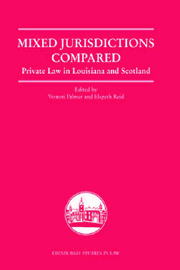Book contents
- Frontmatter
- Contents
- Preface
- List of Contributors
- List of Abbreviations
- Table of Cases
- 1 Praedial Servitudes
- 2 Title Conditions in Restraint of Trade
- 3 Servitudes: Extinction by Non-Use
- 4 Inheritance and the Surviving Spouse
- 5 Ownership of Trust Property in Scotland and Louisiana
- 6 The Legal Regulation of Adult Domestic Relationships
- 7 Impediments to Marriage in Scotland and Louisiana: An Historical-Comparative Investigation
- 8 Contracts of Intellectual Gratification – A Louisiana-Scotland Creation
- 9 The Effect of Unexpected Circumstances on Contracts in Scots and Louisiana Law
- 10 Hunting Promissory Estoppel
- 11 Unjustified Enrichment, Subsidiarity and Contract
- 12 Causation as an Element of Delict/Tort in Scots and Louisiana Law
- 13 Personality Rights: A Study in Difference
- Index
7 - Impediments to Marriage in Scotland and Louisiana: An Historical-Comparative Investigation
Published online by Cambridge University Press: 12 September 2012
- Frontmatter
- Contents
- Preface
- List of Contributors
- List of Abbreviations
- Table of Cases
- 1 Praedial Servitudes
- 2 Title Conditions in Restraint of Trade
- 3 Servitudes: Extinction by Non-Use
- 4 Inheritance and the Surviving Spouse
- 5 Ownership of Trust Property in Scotland and Louisiana
- 6 The Legal Regulation of Adult Domestic Relationships
- 7 Impediments to Marriage in Scotland and Louisiana: An Historical-Comparative Investigation
- 8 Contracts of Intellectual Gratification – A Louisiana-Scotland Creation
- 9 The Effect of Unexpected Circumstances on Contracts in Scots and Louisiana Law
- 10 Hunting Promissory Estoppel
- 11 Unjustified Enrichment, Subsidiarity and Contract
- 12 Causation as an Element of Delict/Tort in Scots and Louisiana Law
- 13 Personality Rights: A Study in Difference
- Index
Summary
INTRODUCTION
The historical development of the law of impediments to marriage in Scotland and Louisiana has proceeded and continues to proceed on closely parallel tracks. In both jurisdictions, the earliest law seems to have been one or another version of the “sacred” law of the Roman Catholic Church (the so-called “canon law”), which, in turn, was in large part but a re-working, in the light of Biblical teaching and Christian moral theology, of post-classical (and, in some respects, even classical) Roman law. In both jurisdictions, this “sacred” law was eventually replaced by “secular” law, a change that, at least at first, had little impact on the actual content of the law. But then, over time and especially in the twentieth century, the secular law of each jurisdiction has progressively been purged of many of the elements within it that were of distinctively canonical origin and of even a few of its Roman law elements. On top of that, in both jurisdictions, the elements that have been so purged, on the one hand, or preserved, on the other, turn out to be very much the same. Still, there remain a few differences, several conspicuous. Examples include the following: (1) Scotland alone continues to recognise the traditional Roman/canon law “impediments” to marriage of “impotence” and “impuberty”; (2) the remaining vestiges of the traditional Roman/canon law impediment of “close relation” vary somewhat from one jurisdiction to the other; and (3) though both jurisdictions continue to recognise the traditional Roman/canon law impediment of “identity of sex”, the rationale for and the strength of commitment to this decision vary widely between the two jurisdictions.
- Type
- Chapter
- Information
- Mixed Jurisdictions ComparedPrivate Law in Louisiana and Scotland, pp. 173 - 207Publisher: Edinburgh University PressPrint publication year: 2009

